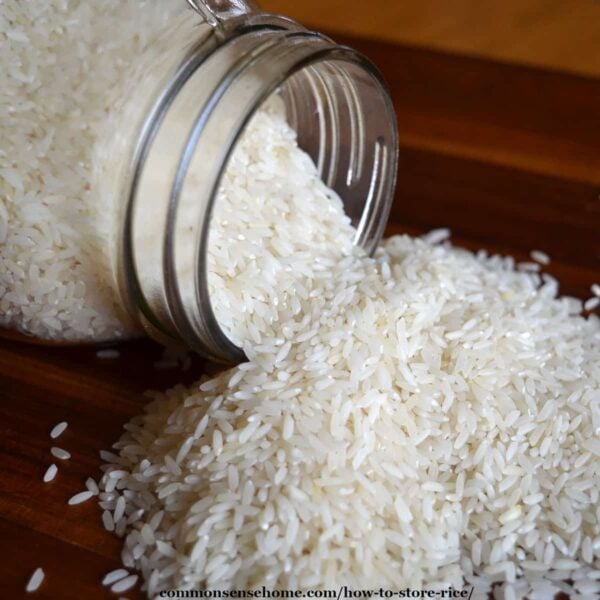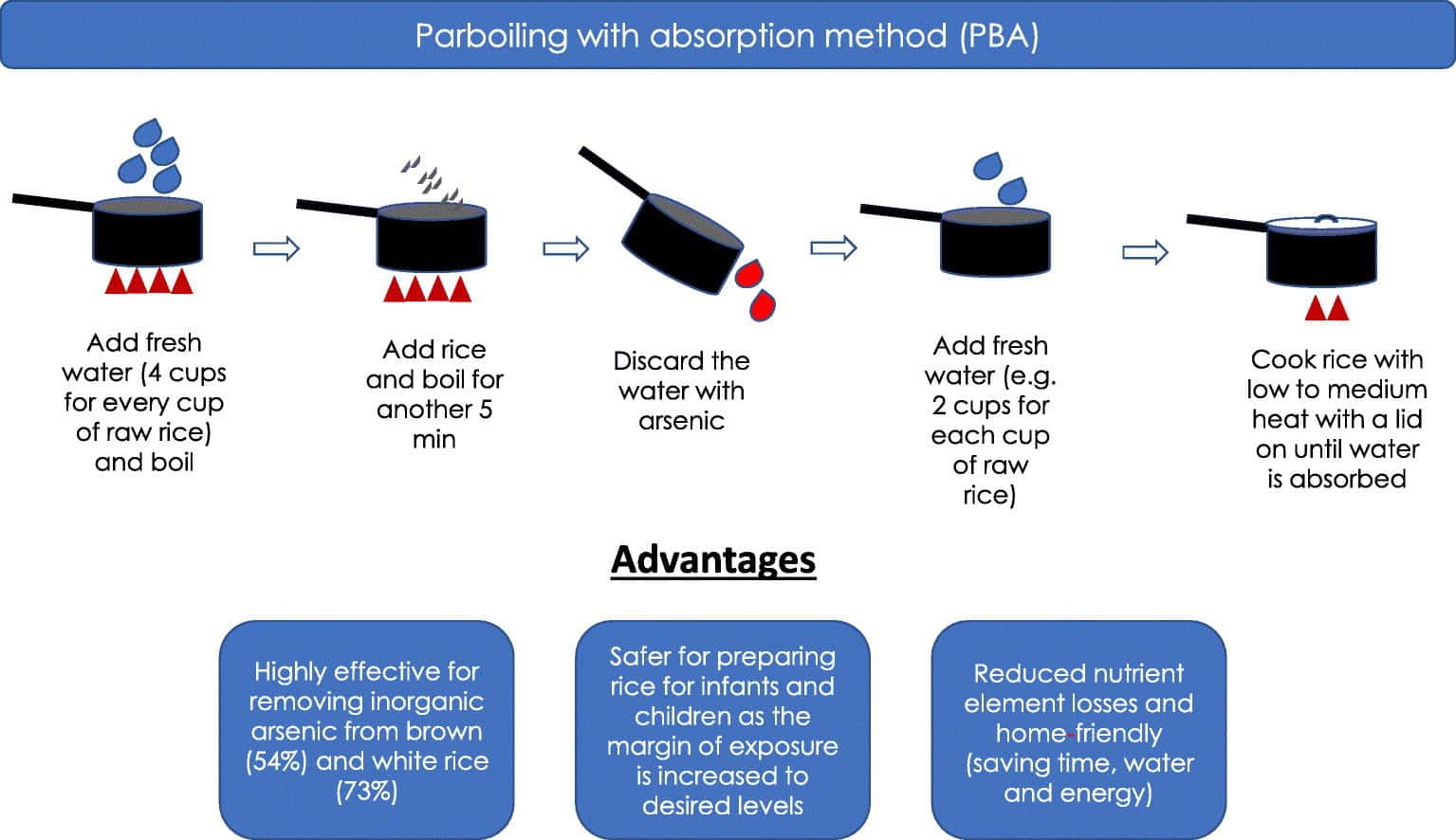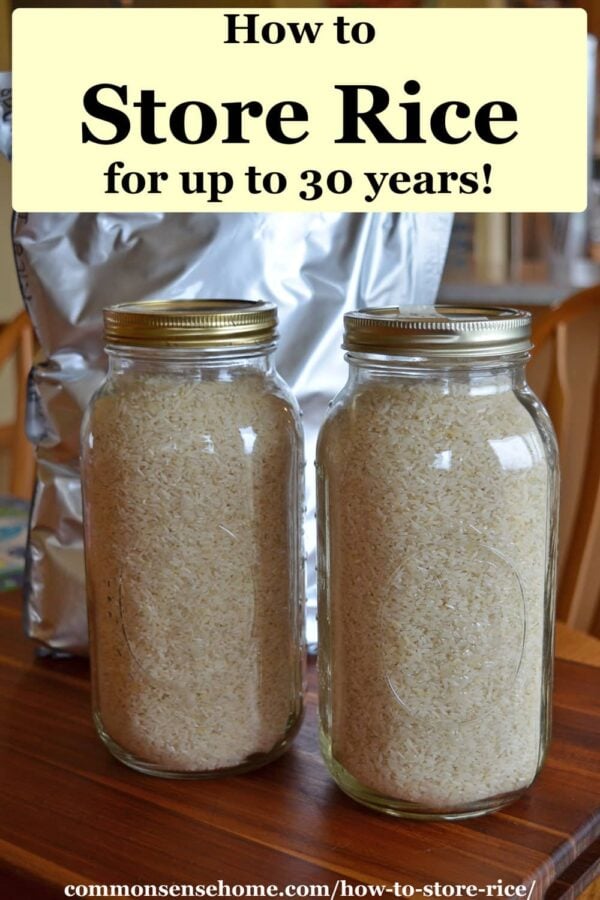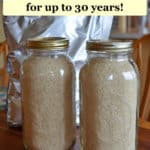How to Store Rice Long Term (Over 20 Years!)
Rice is a great item to include in long term food storage, but you can’t buy a bag from the store and toss it in the pantry. We’ll share how to store rice long term, which rice to store, and answers to some common storage questions.

With the rising popularity of low carb diets, rice has gotten a bad rap, but it’s fed people around the world since at least 8000 B.C. It is inexpensive, especially if you buy it in bulk, and works well in a variety of recipes.
Rice has complex carbohydrates, protein and vitamins, including manganese, niacin, iron, vitamin B6, phosphorus, copper, magnesium and zinc. It’s allergy friendly, and naturally gluten free.
When you cook rice and cool it, it gets higher in resistant starch. Resistant starch acts as a prebiotic, feeding the good bacteria in your gut. (It’s okay to reheat the rice before serving.)
Rice is a great emergency food. Stored properly, it lasts for over 20 years, without refrigeration or freezing.
Which Types of Rice Store Best?
White rice (also known as polished rice), instant rice, and wild rice can last over 30 years, if stored correctly. Brown, black and purple rice will only last around 18 months.
Types of white rice include: long grain, medium grain, and short grain. These include specialty varieties such as Jasmine, Basmati, Arborio, Della, Japanese Premium, Toro, Waxy, and others.
Brown rice and other colored rice has the hull still on. The oil content of the hulls makes them prone to oxidation and spoilage.
A note on instant rice – it stores well and rehydrates quickly, and forms the bulk of many long term survival food meals. It’s fat free, so there’s no fat to go rancid (like brown rice).
That said, uncooked polished rice is a better value for long term storage, because you can store more calories in less space. It’s also normally much cheaper than instant rice, and more shelf stable than instant rice without special packaging.

How to Store Rice Long Term
Like other non-perishable foods, for best storage quality, you need to consider four things:
- Temperature
- Moisture
- Oxygen
- Pests
Find a cool storage location for the rice, away from heat sources. You want to avoid temperature swings, so don’t store rice near stove or a heater. A basement, a root cellar or even under a bed can be good storage places.
The best storage temperature is below 40℉ (5℃ ), but rice stored at a constant 70℉ (21 ℃) will last at least 10 years.
Keep your rice storage dry. Moisture will make your rice more likely to mold. Think about how much rice you use in a month, and keep that much or less in an easy to open container. Keep the rest of your storage tightly sealed so it can’t absorb moisture.
Oxygen equals oxidation (spoilage). Vacuum seal rice or use oxygen absorbers.
To kill any bugs or eggs in stored rice, freeze rice for three days, or seal it in an oxygen free container. (Bugs need to breath, too.) Two weeks without oxygen should kill all bugs and eggs.
Pack rice into insect and rodent proof containers. Mylar® resists insects, but rats and mice can chew through it.

Steps to Store Rice in Mylar®
Gather your supplies before you start. You will need:
- Mylar® bags that are at between 5 mils to 7 mils thick
- Oxygen absorbers
- Sharpie Marker
- 5 or 6 gallon food grade buckets with lids, or other rodent proof containers
- Kitchen scale that can measure 20 pounds
- Mylar® bag sealer
We usually cut a five gallon Mylar® bag in half use it to hold 10 pounds of rice. If you use one 5 gallon bag per bucket, it can hold 30-35 pounds of rice. If you use 1 gallon bags, you will generally only be able to fit 4 in a five gallon bucket.
- Use the Sharpie marker to label the Mylar® bags and the bucket with the date and contents. We stick masking tape on the bucket, and write on the tape.
- Weigh the rice and pour it in the Mylar® bag. Add an oxygen absorber.
- Squeeze out as much air as you can, then seal the bag. Repeat until all rice is in bags.
- Place the bags of rice into your bucket, tote or bin.
Recommended Supplies
Mylar® Bags that are 5 mils or 7 mils thick. Don’t use thin Mylar®, as it can puncture easily and the coating wears off and lets in light.
Purchase 5gal Mylar® with 2000cc oxygen absorbers here
Purchase 1 gallon Mylar® bags with oxygen absorbers here
Oxygen Absorbers
Each Mylar® bag needs at least the following:
- 5 gallon Mylar® bag = 2000cc O2 absorber
- 1 gallon Mylar® bag = 300cc O2 absorber
- 1 quart Mylar® bag or mason jar = 100cc O2 absorber
It’s okay to add extra oxygen absorbers, but don’t use less than the recommended amount, or you may not clear out all the oxygen.
Buy oxygen absorbers sealed in packs of 10 or 20. Don’t open the package of absorbers until the food is ready to be sealed. Only open what you need, then seal leftover absorbers in an airtight container.
Mylar® Heat Sealer
You can use a clothes iron or hair straightening iron to seal Mylar® bags
Handheld Sealer
Impulse sealer (this is tricky to use if the bag is in the bucket already)
Food grade buckets 5gal or 6gal with lids
6gal with screw on lid (strongly recommend Mylar® if you use this, the lids don’t seal as well and can crack)
Sharpie Marker to label the Mylar® bags and buckets
Get a bucket lid opener if you don’t get screw on bucket lids. They’re inexpensive, and much easier to use than a screwdriver. Once sealed, standard lids are tough to pry open.
How much rice is in a 5 gallon bucket?
A five gallon bucket can store about 35 pounds of white rice, if you fill the bucket. We typically pack the rice in bags with 10 pounds of rice each, and put three in a bucket. That way we only open what we can use in a short amount of time.
How to store rice in Mason Jars
To store rice long term in mason jars:
- Place the rice into the jar.
- Vacuum seal the jar or add an oxygen absorber. Use 100cc O2 absorber per quart.
- Screw on the ring for extra protection. Date and label the jar.
Mason jars are airtight and non-reactive, so there’s no aluminum or plastic in contact with your food. The downsides are that they are heavy, don’t hold as much as Mylar® bags can, and are easy to break.
If you have an open container of rice in the pantry, you can add bay leaves to the rice to help deter pantry pests.
Would you like to save this?

How much rice should I store?
How much rice storage you need is up to you. FEMA recommends a minimum of 72 hours of food in your home for all family members.
We recommend a minimum of 7 days, a lot more if you have time and room. A good stock of food will get used, especially if you end up in a hurricane, or other natural disaster, or even a common problem like an unexpected job loss.
The USDA says one pound of uncooked rice equals 1633 calories. 30 pounds, or one 5gal bucket, is about 49,000 calories. An adult needs about 2000 to 2500 calories, more for an active person. That means 49,000 calories is 24 days or less of calories for 1 adult, if you ate nothing but rice.
The Utah State University suggests 25 to 60 pounds of rice per person per year. They recommend a total of 300 pounds of grains per person per year, such as wheat berries, oats, rice, barley, and flour.
Buy your storage rice in bulk to save money, but be sure to taste test before stocking up. You don’t want to be stuck with 200 pounds of rice your family doesn’t like, even if it does last a long time.
Where to Buy Bulk Rice
Many ethnic grocery stores sell bulk rice (often at good prices), as do many warehouse grocery stores. You may also find bulk rice at Mennonite and Church of Latter Day Saints bulk food stores. Buying local avoids extra shipping costs.
Country Life Natural Foods has some bulk rice, such as sticky rice and basmati rice.
Use coupon code “COMMONSENSE10” at checkout to save 10% on your Country Life Natural Foods order.
Azure Standard has an 8.5% shipping charge, monthly drop offs at predetermined locations around the U.S. For orders shipped on Azure’s standard truck routes, a $5 handling fee is charged for orders under $50.
Amazon.com carries a wide variety of bulk rice, including Auguson Farms long grain white rice and Mountain High Organics rice prepacked in storage buckets.
Web Restaurant Store does sell direct to consumers and carries many different types of rice in bulk. Shipping costs tend to be fairly high.
Rice Storage Questions and Answers
These are some questions we’ve run into in preparedness forums.
Why not just store rice in a food grade bucket without Mylar®?
Some people store rice directly in a food grade bucket. We don’t, and here’s why – buckets can fail.
We have been storing food in buckets for 15+ years. During this time, we’ve had multiple buckets fail. Usually the lids crack as the bucket ages. If the food is in Mylar® inside the cracked bucket, it’s still 100% edible and dry.
Why is Mylar® better than the bags the rice comes in?
Rice will absorb moisture and smells. Mylar® keeps out light, moisture, and air, ensuring no oxidation. You can reuse it several times, and it’s impact resistant.
Can I use FoodSaver bags for long term rice storage?
FoodSaver vacuum seal bags are better than the thin bags from the grocery store, but not as good for long term storage as Mylar® or glass.
Several years ago, I vacuum sealed an entire 10 pound bag of sugar in a FoodSaver bag to see how well it would keep. I stored it in our basement canning pantry.
After two years in storage, the sugar in the bag absorbed enough moisture from the air to turn into a solid brick of sugar. Obviously, the FoodSaver bag was not completely airtight.
Why not store rice in the freezer?
You can store white rice in a freezer. If it is in a sealed container it will last indefinitely. The thing is, rice doesn’t need to be frozen. We prefer to save freezer space for food that needs it, and keep rice in a different cool location.
What is the Best Place to Store Rice?
A cool temperature is your goal. A basement, root cellar or even under a bed will work. Avoid a freeze thaw cycle, as the rice will get harder and less palatable.
How to Cook Rice When the Power is Out – 2 Options
If you’re storing rice for emergency food, make sure you have a way to cook it if the power is out. You also need clean water to boil or steam the rice.
1 cup dry rice = 3 cups cooked rice. 2 pounds of dry rice is 5 cups or 15 cups of cooked rice.
To cook rice over a campfire or small emergency stove:
- Rinse the rice in a strainer, let water run through the rice. This reduces any unwanted material, dirt and slightly reduces arsenic.
- Add 2 cups of water for each cup of rice to a pot. Add the water and rice at the same time.
- Boil water and rice add a pinch of salt. DO NOT STIR OR MIX THE RICE or it will get sticky.
- Once it is boiling, turn down to simmer and COVER.
- Let it simmer without stirring or peeking for about 18 minutes.
- Turn off the heat and let the rice rest another 10 minutes
- Fluff the rice with a fork and serve.
To cook rice in a thermos or wonder oven (insulated cooking container):
- Add 1 cup of rice to thermos.
- Boil 2 cups water and pour water into thermos.
- Seal the thermos and place it on its side for two and a half hours.
- Open thermos and eat the rice.
For larger insulated cooking containers, double or triple the amount of rice and water.
What about arsenic in rice?
Brown rice has more arsenic than white rice of the same type grown under the same conditions – on average, 80% more. This is because the arsenic is concentrated in bran and germ. Not all of this arsenic may be absorbed by the body, since it can be bound to the bran.
Rice grown in different areas has different arsenic levels, as do different types of rice. Some of lowest levels of arsenic are found in:
- White basmati rice from California, India and Pakistan
- Sushi rice grown in the United States
Rice grown in Arkansas, Louisiana, and Texas (except sushi rice) has some of the highest levels of arsenic. (Information from the National Celiac Association.)
If you are concerned about the arsenic content in your rice, the Institute for Sustainable Food published a method to cook rice to reduce arsenic while preserving nutrients.

Related Articles
- Long Shelf Life Foods – What Lasts Best (with Chart)
- Bulk Grain – Where to Get it, How to Store it
- How to Store Flour Long Term
- All Food Storage Articles



Learning how to save on the cost of food and how to properly store them
how do you measure the oxygen absorbers, what is 100cc? tell me in US. amounts. they are dry so i need dry measurements please. IE teaspoons, tablespoons or even ounces, not liquid
The US, being the US, likes to mix things up. If you purchase oxygen absorbers, you will find that they are all labeled in ccs, not teaspoons, tablespoons, or ounces.
Oxygen is measured in cubic centimeters (cc), which is a unit of volume. The sizes of oxygen absorbers correspond to the amount of oxygen they absorb. For example, a 300 cc oxygen absorber will absorb 300 cc of oxygen.
You can combine smaller oxygen absorbers, such as two 1000cc absorbers, for the 2000ccs recommended for a 5 gallon bag.
Great article!! I’ve been doing the same for years and have opened up 8 year old rice that appears pretty fresh.
Mylar bags are no where as good as glass. I worked for a company that specialized in the barrier industry, as in water & O2 barrier. Plastic by itself (especially like thin bags) has a poor Water transmission (WTR) & O2 transmission rate (OTR). The shiny coating you see on the Mylar bags is metalized aluminum. Metals offer good WTR & OTR, but are susceptible to micro cracking when the plastic is flexed. A coated bag is still superior to an non-coated bag, regardless of the micro-cracking.
The only possible drawback on mason jars is the silicone gasket surface between the lid and the jar, but the surface area is low, so the WTR & OTR are still very high.
BTW – Mylar is a DuPont trade name, and DuPont has been know to come after people not recognizing the trade mark. Polyester or PET is the generic name
Thanks for the great article, it supported my theory on long term storage of rice.
I agree that glass is superior to plastic for protection, but if impact resistant is an issue, glass might not be a best choice. (Storm damage or earthquakes potentially damaging storage.)
This is something we all should do.
I didn’t see any video link in the article. I looked for the one on pressure sealing the mason jars.
There should be a video right above the heading “Recommended Supplies”. If it’s not displaying, check to make sure that ad blockers are disabled. In the video, Duncan and I vacuum seal mason jars and pack rice in Mylar bags.
Lynne,
The couple in the video demonstrated pressure sealing the mason jars in the video. https://commonsensehome.com/how-to-store-rice/
Video on canning rice cuts off after a few seconds and goes to a video on dehydrating.
Which video were you watching, the one near the top of the article, which is the video sampler, or the one in the section titled “Steps to Store Rice in Mylar”? The one in the Steps to Store Rice in Mylar is the one you want, as it covers storing the rice in Mylar or vacuum sealing in mason jars.
How do I vacuum seal glass jars?
Can you see the video embedded in the post? We demonstrate how to do it with a Food Sealer jar sealer attachment.
There are also hand pump vacuum sealers, and you can use a freeze dryer to vacuum seal jars.
If I use Glass jars and vacuum seal my rice.
How long will it last compared to the date on the bag?
Vacuum sealed white rice should easily last for over 10 years in a cool, dark location.
wouldn’t include “instant rice” in the category of acceptable for long term storage – any processing knocks off durability of the raw grain – a precook most certainly cuts the longevity >>> stick with the long grain white rice and you’ll have no concerns …
need to add pressure cooking – anything to conserve cooking fuel will be of concern when that emergency stored food is most needed …
Instant rice is used in many commercial freeze dried emergency meals because it’s quick to rehydrate and fat free (no rancid fat), so it does keep well, but uncooked polished rice is by far the better value, plus it takes up less room in storage for the same amount of calories.
If you rinse enriched rice, you are washing away the vitamins applied to enrich the rice.
Basmati rice grown in India or California has much lower arsenic levels than rice grown in the American South.
How would you store anything if you only have a crawl space. The cats live under the bed so probably not a good idea
if you put the bed on lifts, you might have room for the cats and for storage. Our cats think that the boxes under the bed are a fun place to hide. For more ideas for finding storage space, see “Preparedness Storage – Finding Room and Keeping it Safe and Sound“,
Pro tip: Don’t buy US rice, US rice fields still have large amount of DDT (arsenic) in the dirt, non-US rice (India, Asia) does not have as much.
As I understand it, it’s been suggested that the arsenic in rice from those southern states may be linked to an arsenic containing pesticide used to control boll weevils in cotton. I’m adding some arsenic info to the article.